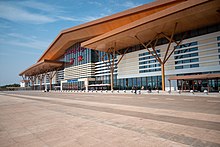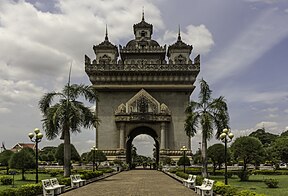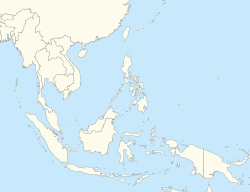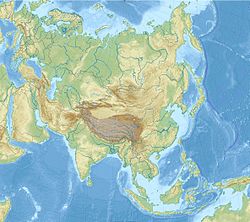Vientiane
Vientiane
ວຽງຈັນ | |
|---|---|
| ນະຄອນຫຼວງວຽງຈັນ | |
 | |
| Coordinates: 17°59′N 102°38′E / 17.98°N 102.63°E | |
| Country | |
| Prefecture | Vientiane Prefecture |
| Settled | 9th century[1] |
| Government | |
| • Mayor | Athsphangthong Siphandone |
| Area | |
• Total | 3,920 km2 (1,510 sq mi) |
| Elevation | 174 m (570 ft) |
| Population (2023[2]) | |
• Total | 840,940 |
| • Density | 210/km2 (560/sq mi) |
| GDP | |
| • Total | US$ 3 billion (2022) |
| • Per capita | US$3,600 (2022) |
| Time zone | UTC+7 (ICT) |
Vientiane (Lao: ວຽງຈັນ) is the capital and largest city of Laos. Situated on the banks of the Mekong River at the Thai border, it comprises the five urban districts of Vientiane Prefecture and had a population of 840,000 as of the 2023 Census. Established as the capital of the Lan Xang Kingdom in 1563, Vientiane served as the administrative center during French rule and retains colonial-era architecture alongside Buddhist landmarks such as Pha That Luang, a national symbol of Buddhism, and Haw Phra Kaew, which once housed the Emerald Buddha until its 18th-century relocation to Thailand.
The city functions as Laos’ administrative and economic hub, emphasizing regional connectivity through infrastructure projects like the Laos-China Railway. This railway, a component of China’s Belt and Road Initiative, terminates in Vientiane after linking Kunming, China, and is slated to connect to Thailand’s rail network via the Mekong Railway Bridge.[4]
Etymology
[edit]"Vientiane" is the French spelling derived from the Lao Viangchan /wíaŋ tɕàn/.[5] The name was previously written "ວຽງຈັນທນ໌" (in Thai, เวียงจันทน์) and later sometimes written "ວຽງຈັນ". In Lao, viang (ວຽງ) refers to a 'walled city' whereas chan (ຈັນ, previously ຈັນທນ໌) derives from Sanskrit candana (चन्दन, /t͡ɕand̪ana/), 'sandalwood' and can be translated as the 'walled city of sandalwood'. Some believe it refers to the 'walled city of the moon' as chan can represent 'moon', and this was previously distinguished in writing as "ຈັນທຣ໌".[5][6] Other romanisations include "Viangchan" and "Wiangchan".[7]
History
[edit]


Dvaravati city state kingdoms
[edit]By the 6th century in the Chao Phraya River Valley, Mon peoples had coalesced to create the Dvaravati kingdoms. In the north, Haripunjaya (Lamphun) emerged as a rival power to the Dvaravati. By the 8th century the Mon had pushed north to create city states, in Fa Daet (what later is Kalasin, northeastern Thailand), Sri Gotapura (Sikhottabong) near Tha Khek, Laos, Muang Sua (Luang Prabang), and Chantaburi (Vientiane). In the 8th century CE, Sri Gotapura (Sikhottabong) was the “strongest of these early city states”, and controlled trade throughout the middle Mekong region. The city states were “loosely bound politically, but were culturally similar” and introduced Therevada Buddhism from Sri Lankan missionaries throughout the region.[10][11][12][13]: 6, 7 [14][15]
Khmer domination
[edit]A reference of the name Vientiane can be seen on a Vietnamese inscription of Duke Đỗ Anh Vũ, dated 1159 during the Khmer-Viet conflict. The inscription says that in 1135, Văn Đan (Vientiane), a vassal of Zhenla (Khmer Empire), invaded Nghe An, and was repelled by the Duke; the Duke led an army chased the invaders as far as Vũ Ôn? (unattested), and then returned with captives.[16]: 65
Lan Xang and French colonial rule
[edit]In 1354, when Fa Ngum founded the kingdom of Lan Xang,[17]: 223 Vientiane became an administrative city. King Setthathirath officially established it as the capital of Lan Xang in 1563, to avoid Burmese invasion.[18]
During French rule, the Vietnamese were encouraged to migrate to Laos, which resulted in 53% of the population of Vientiane being Vietnamese in the year 1943.[19] As late as 1945, the French drew up a plan to move Vietnamese population to 3 key areas (i.e. the Vientiane Plain, the Savannakhet region, and the Bolaven Plateau), which was interrupted by the Japanese invasion of Indochina.[19] If this plan had been implemented, according to Martin Stuart-Fox, the Lao might well have lost control over their own country.[19]
During World War II, Vientiane fell and was occupied by Japanese forces, under the command of Sako Masanori.[20] On 9 March 1946, French paratroopers arrived and reoccupied the city on 24 April 1946.[21]: 736
Independence
[edit]As the Laotian Civil War broke out between the Royal Lao Government and the Pathet Lao, Vientiane became “unstable”. In August 1960, Kong Le seized the capital and insisted that Souvanna Phouma become prime minister. In December, Phoumi Nosavan then seized the capital, overthrew the Phouma Government, and installed Boun Oum as prime minister. In 1975, Pathet Lao troops moved towards the city and Americans began evacuating the capital. On 23 August 1975, a contingent of 50 Pathet Lao women symbolically liberated the city.[21]
Geography
[edit]| Climate data for Vientiane (1991–2020, extremes 1907–) | |||||||||||||
|---|---|---|---|---|---|---|---|---|---|---|---|---|---|
| Month | Jan | Feb | Mar | Apr | May | Jun | Jul | Aug | Sep | Oct | Nov | Dec | Year |
| Record high °C (°F) | 36.0 (96.8) |
38.0 (100.4) |
40.2 (104.4) |
42.6 (108.7) |
42.5 (108.5) |
39.5 (103.1) |
38.2 (100.8) |
37.8 (100.0) |
37.5 (99.5) |
36.8 (98.2) |
36.0 (96.8) |
36.0 (96.8) |
42.6 (108.7) |
| Mean daily maximum °C (°F) | 29.0 (84.2) |
31.0 (87.8) |
33.4 (92.1) |
34.8 (94.6) |
33.6 (92.5) |
32.6 (90.7) |
31.8 (89.2) |
31.4 (88.5) |
31.7 (89.1) |
31.7 (89.1) |
30.8 (87.4) |
28.9 (84.0) |
31.7 (89.1) |
| Daily mean °C (°F) | 22.9 (73.2) |
24.8 (76.6) |
27.4 (81.3) |
29.1 (84.4) |
28.7 (83.7) |
28.4 (83.1) |
27.9 (82.2) |
27.6 (81.7) |
27.6 (81.7) |
27.2 (81.0) |
25.5 (77.9) |
22.9 (73.2) |
26.7 (80.1) |
| Mean daily minimum °C (°F) | 18.2 (64.8) |
19.3 (66.7) |
21.7 (71.1) |
24.2 (75.6) |
25.0 (77.0) |
25.4 (77.7) |
25.3 (77.5) |
25.0 (77.0) |
24.6 (76.3) |
23.9 (75.0) |
21.5 (70.7) |
19.2 (66.6) |
22.8 (73.0) |
| Record low °C (°F) | 2.4 (36.3) |
7.6 (45.7) |
11.7 (53.1) |
13.8 (56.8) |
19.1 (66.4) |
20.0 (68.0) |
19.5 (67.1) |
20.0 (68.0) |
18.8 (65.8) |
12.9 (55.2) |
8.9 (48.0) |
5.0 (41.0) |
2.4 (36.3) |
| Average precipitation mm (inches) | 7.4 (0.29) |
16.8 (0.66) |
43.8 (1.72) |
89.4 (3.52) |
225.6 (8.88) |
263.8 (10.39) |
299.8 (11.80) |
340.8 (13.42) |
265.0 (10.43) |
87.4 (3.44) |
15.4 (0.61) |
5.0 (0.20) |
1,663.2 (65.48) |
| Average precipitation days (≥ 1.0 mm) | 2 | 2 | 5 | 7 | 15 | 18 | 20 | 21 | 17 | 8 | 2 | 1 | 119 |
| Average relative humidity (%) | 70 | 68 | 66 | 69 | 78 | 82 | 82 | 84 | 83 | 78 | 72 | 70 | 75 |
| Mean monthly sunshine hours | 221.0 | 214.7 | 209.2 | 213.9 | 188.8 | 140.7 | 116.0 | 124.3 | 157.7 | 209.5 | 225.3 | 224.9 | 2,246 |
| Source 1: World Meteorological Organization,[22] Deutscher Wetterdienst (extremes 1907–1990),[23] Pogoda.ru.net,[24] The Yearbook of Indochina (1939–1940)[25] | |||||||||||||
| Source 2: NOAA (humidity 1961–1990),[26] Extreme Temperature Around The World [27] | |||||||||||||
Tourism
[edit]

The capital attracts tourists to its temples and Buddhist monuments. An attraction is Pha That Luang, a national cultural monument of Laos and 1 of its stupas. It was originally built in 1566 by King Setthathirath and was restored in 1953. The golden stupa is 45 metres (148 ft) tall and is believed to contain a relic of the Buddha.[28]
The Wat Si Muang temple was built on the ruins of a Khmer Hindu shrine, the remains of which can be seen behind the ordination hall.[29] It was built in 1563 and is believed to be guarded by the spirit of a local girl, Nang Si. Legend tells that Nang Si, who was pregnant at the time, leapt to her death as a sacrifice, just as the pillar was being lowered into the hole. In front of the temple stands a statue of King Sisavang Vong.[29]
The memorial monument, Patuxai, built between 1957 and 1968, is a landmark in the city.[28]
Buddha Park was built in 1958 by Luang Pu Bunleua Sulilat and contains a collection of Buddhist and Hindu sculptures, scattered amongst gardens and trees. The park is 28 kilometres (17 mi) south of Vientiane at the edge of the Mekong River.[30]
Other sites include:
- Haw Phra Kaew, former temple, later a museum and shops
- Lao National Museum
- Kaysone Phomvihane Museum
- Talat Sao, a morning market
- That Dam, a large stupa
- Wat Ong Teu Mahawihan, a Buddhist monastery
- Wat Sri Chomphu Ong Tue, a Buddhist temple
- Wat Si Saket, Buddhist wat
- Wat Sok Pa Luang, a Buddhist temple
- Settha Palace Hotel, established 1932
- The Sanjiang Market[31]

Education
[edit]The National University of Laos, 1 of 3 universities in the country, is in Vientiane.[32]
International schools include:
- Vientiane International School
- Lycée français international de Vientiane Josué-Hoffet (French)[33]
- Russian Embassy School in Vientiane
Broadcasting
[edit]- Lao National Radio has a mediumwave transmitter with a 277-metre guyed mast at 18°20′33″N 102°27′01″E / 18.34250°N 102.45028°E.
- China Radio International (CRI) FM 93.0.[34]
Economy
[edit]Vientiane has experienced economic growth from foreign investment.[35] In 2011, the stock exchange opened with 2 listed company stocks, with the cooperation of South Korea.[36]
Transportation
[edit]By bus
[edit]
There are regular bus services connecting Vientiane Bus Station with the rest of the country. In Vientiane, regular bus services around the city are provided by Vientiane Capital State Bus Enterprise.[38]
By rail
[edit]
A metre gauge railway link over the first bridge was formally inaugurated on 5 March 2009, previously ending at Thanaleng Railway Station, in Dongphosy village (Vientiane Prefecture), 20 km east of Vientiane.[39][40] As of November 2010, Lao officials plan to convert the station into a cargo rail terminal for freight trains, allowing cargo to be transported from Bangkok into Laos more cheaply than via road.[41]
The Boten–Vientiane railway (sometimes referred to as the China–Laos railway or Laos–China railway) is a 414 kilometres (257 mi) 1,435 mm (4 ft 8+1⁄2 in) standard gauge electrified railway in Laos, running between the capital Vientiane and the town of Boten on the border with China. The line was officially opened on 3 December 2021.[42]
By air
[edit]
Vientiane is served by Wattay International Airport with international connections to other Asian destinations such as Singapore, Hong Kong, Malaysia, Thailand, South Korea, Japan and China. Lao Airlines has regular flights to domestic destinations in the country (including flights daily to Luang Prabang, plus flights weekly to other local destinations).[43]
Healthcare
[edit]The "Centre Medical de l'Ambassade de France" is available to the foreign community in Laos. The Mahosot Hospital is a local hospital in treating and researching diseases and is connected with the University of Oxford. In 2011 the Alliance Clinic opened near the airport, with a connection to Thai hospitals. The Setthathirat International Clinic has foreign doctors. A free, 24/7 ambulance service is provided by Vientiane Rescue, a volunteer-run rescue service established in 2010.[44]
See also
[edit]Notes
[edit]References
[edit]- ^ Lao Statistics Bureau (21 October 2016). "Results of Population and Housing Census 2015" (PDF). Archived from the original on 30 June 2020. Retrieved 8 January 2018.
- ^ Vientiane Capital
- ^ Vientiane Capital Records 4.83% Economic Growth in 2022
- ^ "The World According to GaWC 2020". GaWC - Research Network. Globalization and World Cities. Archived from the original on 24 August 2020. Retrieved 31 August 2020.
- ^ a b Askew, Marc; Long, Colin; Logan, William (2006). Vientiane: Transformations of a Lao Landscape. Routledge. pp. 15, 46. ISBN 978-1-134-32365-4. Archived from the original on 16 November 2023. Retrieved 22 November 2020.
- ^ Goscha, Christopher E.; Ivarsson, Søren (2003). Contesting Visions of the Lao Past: Laos Historiography at the Crossroads. NIAS Press. pp. 34 n.62, 204 n.18. ISBN 978-87-91114-02-1. Archived from the original on 16 November 2023. Retrieved 22 November 2020.
- ^ "Definition of 'Viangchan'". Collins English Dictionary. Glasgow: HarperCollins. Archived from the original on 11 June 2019. Retrieved 11 June 2019.
Viangchan in British. (ˌwiːɛŋˌtæn). noun: another spelling of Vientiane
- ^ Lorrillard, Michel (12 November 2019), The Diffusion of Lao Scripts (PDF), p. 6, archived (PDF) from the original on 20 September 2021, retrieved 26 February 2021
- ^ Mon inscription in Laos, archived from the original on 7 March 2021, retrieved 26 February 2021
- ^ Maha Sila Viravond. "HISTORY OF LAOS" (PDF). Refugee Educators' Network. Archived (PDF) from the original on 3 April 2020. Retrieved 29 December 2017.
- ^ M.L. Manich. "HISTORY OF LAOS (including the history of Lonnathai, Chiangmai)" (PDF). Refugee Educators' Network. Archived (PDF) from the original on 17 May 2017. Retrieved 29 December 2017.
- ^ Martin Stuart-Fox (6 February 2008), Historical Dictionary of Laos, Scarecrow Press, p. 328, ISBN 9780810864115, archived from the original on 24 January 2023, retrieved 26 February 2021
- ^ Phra Thep Rattanamoli (1976). "The That Phanom chronicle : a shrine history and its interpretation". Archived from the original on 7 February 2021. Retrieved 27 February 2021.
- ^ Kislenko, Arne (2009), Culture and Customs of Laos, Bloomsbury Academic, p. 19, ISBN 9780313339776, archived from the original on 24 January 2023, retrieved 26 February 2021
- ^ "The Mon and Khmer Kingdoms". 31 March 2015. Archived from the original on 24 September 2021. Retrieved 26 February 2021.
- ^ Taylor, K. W. (1995). Essays Into Vietnamese Pasts. Cornell University Press. ISBN 978-1-501-71899-1.
- ^ Coedès, George (1968). Walter F. Vella (ed.). The Indianized States of Southeast Asia. trans.Susan Brown Cowing. University of Hawaii Press. ISBN 978-0-8248-0368-1.
- ^ "Vientiane marks 450 years anniversary". Archived from the original on 16 August 2011. Retrieved 18 July 2015.
- ^ a b c Stuart-Fox, Martin (1997). A History of Laos. Cambridge University Press. p. 51. ISBN 978-0-521-59746-3. Archived from the original on 24 August 2023. Retrieved 30 June 2020.
- ^ "Far East and Australasia". Archived from the original on 21 November 2010. Retrieved 25 November 2010.
- ^ a b Stuart-Fox, Martin (2002). "Laos: History". The Far East and Australasia 2003. Regional surveys of the world. Psychology Press. pp. 735–742. ISBN 9781857431339. Archived from the original on 10 May 2016. Retrieved 20 February 2023.
- ^ "World Meteorological Organization Climate Normals for 1991–2020". World Meteorological Organization. Archived from the original on 16 July 2021. Retrieved 2 August 2023.
- ^ "Klimatafel von Vientiane (Viangchan) / Laos" (PDF). Baseline climate means (1961–1990) from stations all over the world (in German). Deutscher Wetterdienst. Archived (PDF) from the original on 5 March 2020. Retrieved 23 January 2016.
- ^ КЛИМАТ УЛАН-БАТОРА (in Russian). Pogoda.ru.net. Archived from the original on 16 November 2023. Retrieved 4 January 2015.
- ^ "The Yearbook of Indochina (1939-1940)" (PDF). Archived (PDF) from the original on 16 June 2023. Retrieved 16 June 2023.
- ^ "Vientiane Climate Normals 1961–1990". National Oceanic and Atmospheric Administration. Archived from the original on 17 July 2020. Retrieved 29 November 2013.
- ^ "January record low". Retrieved 3 July 2023.
- ^ a b Lao National Tourism Administration – Tourist Sites in Vientiane Capital Archived 23 July 2011 at the Wayback Machine
- ^ a b "Wat Si Muang". Archived from the original on 10 February 2008. Retrieved 18 July 2015.
- ^ "Buddha Park – Vientiane – Laos – Asia for Visitors". Archived from the original on 1 June 2015. Retrieved 18 July 2015.
- ^ "China Gives Southeast Asia's Poorest First Time Access to Consumer Goods – China Briefing News". China Briefing News. 23 January 2008. Archived from the original on 14 May 2014. Retrieved 7 May 2012.
- ^ "National University of Laos (NUOL)". National University of Laos (NUOL). NUOL. Archived from the original on 1 August 2017. Retrieved 8 December 2014.
- ^ "Lycée français international de Vientiane Josué-Hoffet". AEFE. Archived from the original on 16 June 2023. Retrieved 16 June 2023.
- ^ "China Radio International". Archived from the original on 4 February 2011. Retrieved 11 February 2011.
- ^ Work begins on major new Vientiane shopping centre | Lao Voices Archived 3 May 2011 at the Wayback Machine
- ^ "Laos stocks soar on debut – yes, both of them". Financial Times. Archived from the original on 27 July 2011.
- ^ Matthias Gasnier (13 August 2012). "Laos 2012 Update: Chinese models keep spreading". bestsellingcarsblog.com. Archived from the original on 7 December 2013. Retrieved 10 November 2013.
- ^ "Timetables". Vientiane Capital State Bus Enterprise. VCSBE. Archived from the original on 1 June 2015. Retrieved 8 December 2014.
- ^ "Inaugural train begins Laos royal visit". Railway Gazette International. 5 March 2009. Archived from the original on 22 July 2010. Retrieved 3 August 2009.
- ^ Andrew Spooner (27 February 2009). "First train to Laos". The Guardian. Archived from the original on 11 November 2014. Retrieved 13 March 2011.
- ^ Rapeepat Mantanarat (9 November 2010). "Laos rethinks rail project". TTR Weekly. Archived from the original on 27 July 2011. Retrieved 13 March 2011.
- ^ "中老铁路今日通车-图片新闻-中华人民共和国交通运输部". www.mot.gov.cn. Archived from the original on 3 December 2021. Retrieved 3 December 2021.
- ^ "Route Map". Lao Airlines. Archived from the original on 1 August 2017. Retrieved 8 December 2014.
- ^ "About". Vientiane Rescue. Archived from the original on 11 October 2016. Retrieved 11 October 2016.
Further reading
[edit]- Askew, Marc, William Stewart Logan, and Colin Long. Vientiane: Transformations of a Lao Landscape. London: Routledge, 2007. ISBN 978-0-415-33141-8
- Sharifi et al., Can master planning control and regulate urban growth in Vientiane, Laos?. Landscape and Urban Planning, 2014. DOI: 10.1016/j.landurbplan.2014.07.014
- Flores, Penelope V. Good-Bye, Vientiane: Untold Stories of Filipinos in Laos. San Francisco, CA: Philippine American Writers and Artists, Inc, 2005. ISBN 978-0-9763316-1-2
- Renaut, Thomas, and Arnaud Dubus. Eternal Vientiane. City heritage. Hong Kong: Published by Fortune Image Ltd. for Les Editions d'Indochine, 1995.
- Schrama, Ilse, and Birgit Schrama. Buddhist Temple Life in Laos: Wat Sok Pa Luang. Bangkok: Orchid Press, 2006. ISBN 978-974-524-073-5
- Women's International Group Laos. Vientiane Guide. Vientiane: Women's International Group, 1993.
External links
[edit] Vientiane travel guide from Wikivoyage
Vientiane travel guide from Wikivoyage
- Capitals in Asia
- Districts of Laos
- Laos–Thailand border crossings
- Populated places established in 1560
- Populated places in Laos
- Populated places in Vientiane Province
- Vientiane
- 16th century in Lan Xang
- 17th century in Lan Xang
- 18th century in Vientiane
- 19th century in Vientiane
- 9th-century establishments in Asia







